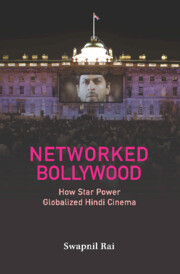Book contents
- Frontmatter
- Dedication
- Contents
- List of Figures
- List of Tables
- Acknowledgements
- List of Abbreviations
- Introduction: Star Switching Power in Networked Bollywood
- 1 Of Vagabonds and Wayfarers: Raj Kapoor, Dev Anand, and Hindi Cinema’s Family-Led Film Clusters
- 2 King of Kings: Amitabh Bachchan and the Emergence of Bollywood’s Corporate Networks
- 3 Global Dreamz: Shah Rukh Khan and Aamir Khan Usher Global Bollywood into the New Millennium
- 4 Global Beauty Queens: Aishwarya Rai, Priyanka Chopra, and Female Star Switching Power
- 5 Bards of Change: How Streaming Platforms and State–Industry Alliance Are Reconfiguring Star Power in Networked Bollywood
- Notes
- Index
1 - Of Vagabonds and Wayfarers: Raj Kapoor, Dev Anand, and Hindi Cinema’s Family-Led Film Clusters
Published online by Cambridge University Press: 09 January 2024
- Frontmatter
- Dedication
- Contents
- List of Figures
- List of Tables
- Acknowledgements
- List of Abbreviations
- Introduction: Star Switching Power in Networked Bollywood
- 1 Of Vagabonds and Wayfarers: Raj Kapoor, Dev Anand, and Hindi Cinema’s Family-Led Film Clusters
- 2 King of Kings: Amitabh Bachchan and the Emergence of Bollywood’s Corporate Networks
- 3 Global Dreamz: Shah Rukh Khan and Aamir Khan Usher Global Bollywood into the New Millennium
- 4 Global Beauty Queens: Aishwarya Rai, Priyanka Chopra, and Female Star Switching Power
- 5 Bards of Change: How Streaming Platforms and State–Industry Alliance Are Reconfiguring Star Power in Networked Bollywood
- Notes
- Index
Summary
Particularly during the Cold War years, you will find that the entire Eastern side was absolutely seduced by Indian cinema. I remember the one time we all went to the former Soviet Union as part of the Indian delegation for the Moscow Film Festival. We were travelling from Moscow to St. Petersburg by overnight train. There was a special coupe in which the Czars used to travel that was brought out and attached to the train; why? Because Raj Kapoor was travelling with us. And Raj Kapoor being Raj Kapoor, he invited many of us in that coupe where the Russians had provided him with an endless supply of champagne, cognac, and fruit. Their own leaders never got the kind of treatment that Raj Kapoor received.
—Shyam Benegal, veteran film director and producerRaj Kapoor, as the anecdote emphasizes, was a revered star in the Soviet Union when a newly independent India was trying to establish itself as a non-aligned nation in the context of the Cold War. His film Awāra (The Vagabond, 1951) was an unexpected hit that endeared Soviet viewers to Indian cinema. Concurrently, the Soviets appreciated a few other major stars such as Dev Anand and Dilip Kumar, whose films Rahi (The Wayfarer, 1952, dir. Khwaja Ahmad Abbas) and Naya Daur (The New Era, 1957, dir. B. R. Chopra) also got Soviet releases. This chapter traces the history of Indian Hindi cinema’s industrial exchange and globalization, from the 1950s to the 1980s, spanning the decades of the Cold War up to the beginnings of perestroika in the Union of Soviet Socialist Republics, commonly referred to as the Soviet Union. In recounting this history, it focuses on crucial star nodes and their nodal power within Indian Hindi cinema’s formative industrial structure after independence. While recounting this history of star switching power, this chapter also situates how stars came to be Hindi cinema’s global anchors with the most industrial power, when, during the late 1940s and early 1950s, the studio system that existed under British rule broke down. Indian Hindi cinema’s post-independence industrial structure, we will see, was marked by significant transformations. The studios were replaced by a new structural formation wherein small independent film clusters dominated the production landscape.
- Type
- Chapter
- Information
- Networked BollywoodHow Star Power Globalized Hindi Cinema, pp. 26 - 76Publisher: Cambridge University PressPrint publication year: 2024



